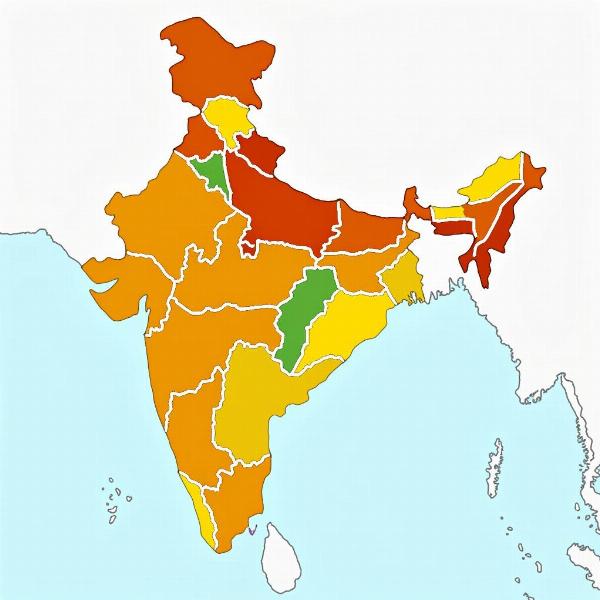Understanding the meaning and usage of “je” in Hindi can be tricky for non-native speakers. This article aims to provide a complete understanding of “je” in Hindi, exploring its various meanings, grammatical functions, and cultural contexts. We’ll delve into practical examples and common phrases to help you confidently incorporate “je” into your Hindi vocabulary.
Decoding “Je”: Meanings and Contexts
“Je” isn’t a standalone word with a direct English translation. It’s a suffix added to pronouns and sometimes nouns, altering their meaning and function within a sentence. Think of it as a small but mighty grammatical tool that adds shades of meaning and politeness.
“Je” as a Marker of Respect
One of the most common uses of “je” is to express respect. When added to pronouns like “aap” (you), it elevates the level of formality. For example, “aap je” is a more respectful way of addressing someone than simply “aap.” This usage is particularly prevalent in formal settings or when interacting with elders.
“Je” Indicating Emphasis or Plurality
In certain dialects, “je” can also add emphasis or indicate plurality. While not as widespread as its respectful usage, this function is worth noting. For instance, “tum je” (you all) can emphasize the group being addressed.
“Je” in Specific Regional Dialects
It’s crucial to remember that the usage and prevalence of “je” can vary significantly across different Hindi dialects. In some regions, it’s a common part of daily speech, while in others, it might be used sparingly or not at all.
 Regional Variations of "Je"
Regional Variations of "Je"
Common Phrases and Examples Using “Je”
Understanding how “je” is used in everyday conversations is key to mastering its nuances. Here are a few examples:
- Aap je kaise hain? (How are you, sir/madam?): This is a polite and respectful way to inquire about someone’s well-being.
- Kya aap je yah kar sakte hain? (Could you please do this?): Adding “je” softens the request, making it more courteous.
- Unhone je kaha… (He/She said…): Using “je” after a pronoun when reporting someone’s speech can indicate respect for the person being quoted.
“Je” vs. Other Respectful Suffixes
“Je” is not the only suffix used to convey respect in Hindi. Other suffixes like “ji” and “sahab/sahiba” also serve similar purposes. Understanding the subtle differences between these suffixes can further refine your Hindi communication.
“Ji” – A More Common Honorific
“Ji” is perhaps the most frequently used respectful suffix in Hindi. It’s generally more versatile than “je” and can be added to names, titles, and pronouns.
“Sahab/Sahiba” – For Formal Titles
“Sahab” (for males) and “sahiba” (for females) are typically used with formal titles or professions, like “Doctor Sahab” or “Professor Sahiba.”
Conclusion: Mastering the Nuances of “Je”
While seemingly a small addition, “je” plays a significant role in expressing respect and adding nuance to Hindi conversations. By understanding its various meanings and regional variations, you can enhance your communication skills and demonstrate cultural sensitivity. Remember that practice is key to mastering the subtle art of using “je” appropriately. So, immerse yourself in the language, observe how native speakers use it, and don’t hesitate to experiment!
FAQ: Common Questions about “Je”
- Is “je” always used to show respect? While primarily used for respect, it can also indicate emphasis or plurality in some dialects.
- Can “je” be used with all pronouns? It’s most commonly used with “aap” (you) and sometimes with “tum” (you).
- Is “je” used in written Hindi? Yes, it’s used in both spoken and written Hindi, particularly in formal writing.
- What happens if I don’t use “je”? While not always grammatically incorrect, omitting “je” in situations where it’s expected might be perceived as impolite.
- Is it essential to learn about “je”? Understanding “je” deepens your comprehension of Hindi grammar and cultural nuances, enhancing your ability to communicate effectively.
- How can I practice using “je” correctly? Engage in conversations with native speakers and pay attention to their usage of “je.”
- Are there any online resources to learn more about Hindi suffixes? Yes, various online dictionaries and language learning platforms provide detailed explanations and examples.
Meaning-Hindi.in: Your Partner in Hindi Language Solutions
Meaning-Hindi.in is your one-stop solution for all your Hindi translation needs. We offer a wide range of professional translation services, including business and commercial document translation, certified and legal document translation, technical and user manual translation, website localization, educational and academic translation, express translation, and specialized translation across various domains. Need help navigating the intricacies of Hindi grammar like understanding “je”? Our expert linguists are proficient in the nuances of the language and culture. Contact us today for accurate, culturally sensitive, and high-quality translations.
Email: [email protected]
Phone: +91 11-4502-7584
Connect with Meaning-Hindi.in for seamless communication and bridge the language gap with confidence.